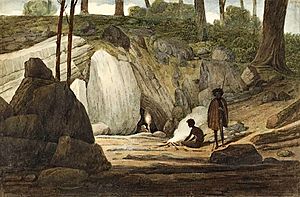Wellington Caves facts for kids
Quick facts for kids Wellington Caves |
|
|---|---|
| Geology | Early Devonian limestone |
The Wellington Caves are a collection of amazing limestone caves. You can find them about 8 kilometers (5 miles) south of Wellington, New South Wales, in Australia. These caves are famous for their beautiful rock formations and the ancient fossils found inside.
Contents
Discovering the Wellington Caves
The land around Wellington was home to the Binjang mob of the Wiradjuri people for a very long time. They knew about the caves, even if they didn't go deep inside them. A painting from 1826 by Augustus Earle shows Aboriginal people near the entrance of Cathedral Cave. This painting is the first written record of the caves.
The first Europeans to explore the caves were likely part of Lieutenant Percy Simpson's group (1823–1831). The explorer Hamilton Hume wrote the first detailed account in 1828. Just two years later, George Ranken, a local leader, made an exciting discovery. He found fossil bones of a diprotodon and a giant kangaroo inside the caves. The diprotodon was a huge plant-eating animal that lived during the Ice Age.
Ranken returned with Sir Thomas Mitchell and collected many more bones. It seems the caves acted like a natural trap for animals, preserving their remains. These bones became a big topic for scientists in London in 1831. Since then, the caves have taught us a lot about ancient geology and animals.
Protecting the Caves
Sadly, people damaged the caves a lot in the 1800s. To protect them, the caves were made a natural reserve in 1884. Guided tours of Cathedral Cave started around 1885. James Sibbald was the first person hired to look after the caves.
Gaden Cave was found in 1902 and opened for tours in 1909. There was also a Phosphate Mine here, which operated from 1914 to 1918. Not much phosphate was found, and the mine closed. But in 1996, the mine passages were rebuilt and reopened for visitors. Today, you can take guided tours of Cathedral Cave, Gaden Cave, and the Phosphate Mine.
Over the years, members of the Sydney University Speleological Society (SUSS) have explored and mapped many new parts of the caves. They have even explored underwater sections. There are now 26 known caves in the reserve. Important discoveries include McCavity Cave, an underground lake, and the rediscovery of Anticline Cave.
How the Caves Formed
The Wellington Caves are found in a type of rock called limestone. This limestone is very old, about 400 million years old! It formed during the Devonian period. Over millions of years, water slowly dissolved the limestone, creating the amazing tunnels and chambers we see today.
Visiting the Caves
The Wellington Caves have been a popular place to visit for a long time. By 1888, more than 1,500 people visited each year. By 2005, over 50,000 people were visiting the caves every year!
Main Caves to Explore
Cathedral Cave
Cathedral Cave has been open for guided tours since 1885. It is famous for a giant stalagmite called Altar Rock. This amazing rock formation is 32 meters (105 feet) around its base and more than 15 meters (49 feet) tall!
Scientists digging here found bones of a new type of bat. This bat lived millions of years ago and was related to the modern ghost bat. The new species was named Macroderma koppa. This name comes from Koppa, a spirit that local Aboriginal people believed lived in the cave.
Gaden Cave
Gaden Cave opened for guided tours in 1909. It is known for its unusual and beautiful cave coral. This cave was named after the local leader who was in charge when it was discovered.
Phosphate Mine
The Phosphate Mine opened for guided tours in 1996. When you visit, you can see the old mining tunnels. You can also see deposits of fossil bones that are 800,000 years old!
Other Caves
Many other caves at Wellington are not open for visitors.
Lime Kiln Cave
Lime Kiln Cave is the dry part of a much larger cave system. Most of this system is filled with water.
McCavity
McCavity is the underwater part of a cave. It was discovered by members of the Sydney University Speleological Society.
Water Cave (Anticline Cave)
This is a small cave that leads to water. It is currently being reopened for exploration.
Big Sink
This is an old, collapsed cave entrance. It seems to be where fossil-filled dirt washed into the cave chambers below.
Mitchell's Cave
This is the place where George Ranken collected the first Australian fossils for scientific study.
- Mike Augee, Chris George and Bruce Welch, Wellington Caves, Wellington Caves Fossil Studies Centre 2008 ISBN: 978-0-9805289-0-9.
- Joan Starr and Doug McMillan, The Wellington Caves. Treasure Trove of Fossils, Dubbo, Macquarie Publications, 1985.
- Kent Henderson, The Wellington Caves and Abercrombie


